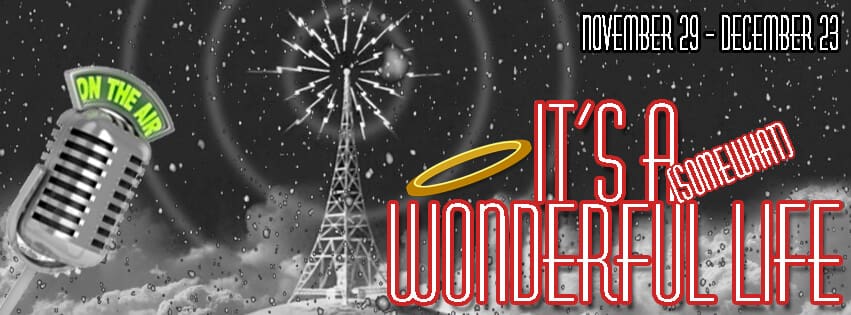- Skip to primary navigation
- Skip to secondary navigation
- Skip to main content
- Skip to primary sidebar
It Started With The Felons: Scott on “A Wonderful Life”
“It’s A Wonderful Life” did not enter the world as a fully-formed classic film from the mind of Frank Capra. Like many great American tales, the story of George Bailey and his trip through the looking glass into a world where he had never been born was discovered in the bathroom.
On February 28, 1938 Philip Van Doren Stern was in his bathroom shaving and, so he claims, he got an idea so powerful and so complete that it nearly took his breath away. Looking into the mirror, face covered in shaving cream and his privates covered by a towel, Phil (I can call him Phil) said that the story of a man named George who, with the assistance of a heavenly supernatural power, understands what the world would be like if he had never been, came to him in toto, from beginning to end, in one moment of divine inspiration.
Now, many of us have felt inspired while wearing nothing but a towel…I know I have…but Phil’s inspiration was resulted not in a warrant but rather in a neat and tidy 24 pages of typed script. He called his mini-epic The Greatest Gift and immediately began handing it to every publisher and editor he could find.
No one wanted it. No one. Nada.
But Phil didn’t give up easily. In fact, Phil had faced his share of difficulties in his day. Phil was a historian and an editor of short story collections in the 1920s and 30s, and was responsible for collecting and editing the writings and letters of such important historical figures as Abraham Lincoln, Thoreau and Edgar Allan Poe. Phil was a hard worker, a dreamer, a “pull yerself up by your bootstraps” kinda guy, and he didn’t give up on The Greatest Gift. Instead, he had his story printed, with his own dime, and started handing them out to his friends and colleagues as…yep…Christmas Gifts.
One of the people he gave a copy to Hollywood producer David Hampstead. Hampstead showed it to Cary Grant. Cary Grant was interested in doing it as a feature film so RKO pictures purchased the rights to The Greatest Gift for $10,000. The little book was adapted and treated no less than 3 times before it was determined, by everyone involved, that it just wouldn’t fly…not gonna happen…never going to make it. Sorry.
Until September 1, 1945 when RKO chairman Charles Koerner offloaded all three versions of the story, plus Phil’s original booklet, (for the same $10,000 RKO had spent to acquire the rights) to a previously successful Hollywood director who was returning from WWII.
That man was Frank Capra. Capra had recently worked with Jimmy Stewart (another veteran of the war) on Mister Smith Goes To Washington and Jimmy and Capra both saw this little “holiday story that could” as an ideal vehicle to help them re-climb the Hollywood ladder.
It’s A Wonderful Life opened two weeks before Christmas in 1946. Capra and his studio promoted the living hell out of the film but, even so, the movie got pretty lackluster reviews in America and the British…well, they hated it.
The problem? Well, people thought that they were buying tickets for a light-hearted romantic Christmas fable and, instead, they got a “Dante-esque vision of drunkenness, despair and suicide.” Talk about your sleight of hand…
The movie was nominated for five Oscars but didn’t receive any. One critic said, “Capra might well have wished his little movie had never been born…”
So how did this story become a mainstay of the American Christmas season? Our own little Uncle-Sam-Style Christmas Carol? Two reasons, mostly.
It started with the felons.
Seriously.
Patrick Coffin in his December 2012 story for the National Review writes, “Less than a year after the film’s anti-climactic debut, the warden of San Quentin prison mailed him a bag stuffed with more than 1,500 letters scrawled by inmates; the letters told of the film’s impact on them. For decades to come, the letters kept arriving, and Capra personally answered every one of them. He knew that his movie had reached “his people.”
Second?
Someone screwed up in legal.
Josh Levin of Slate.com writes, “It’s a Wonderful Life entered the public domain by accident. In 1946, when the movie was filmed, U.S. copyright protection lasted 28 years and could be renewed for another 28 years by filing some paperwork and paying a nominal fee. However, Republic Pictures, the original copyright owner and producer of Wonderful Life, neglected to renew the 1946 copyright in 1974. So, the film entered the public domain. Though a box office flop on release, it became immensely popular on television thanks to repeated showings: Stations programmed it heavily during the holidays, paying no royalties to its producers, and more than 100 distributors sold the movie on tape.”
Talk about your comedy of errors!
Although Capra’s movie is a perennial favorite for families, it hasn’t always been seen with such a forgiving eye. Not only was it panned when it first appeared, it has, more recently, come under fire from both the left and the right.
Wendell Jamieson, in a 2008 New York Times essay, assures us that—far from the “cheery holiday tale” it’s thought to be— It’s a Wonderful Lifeis actually “a terrifying, asphyxiating story about growing up and relinquishing your dreams . . . of being trapped, of compromising, of watching others move ahead and away, of becoming so filled with rage that you verbally abuse your children, their teacher and your oppressively perfect wife.”
Yipes.
Not to be outdone, Kyle Smith in a 2007 New York Post column celebrates Mr. Potter as “the unsung hero of It’s a Wonderful Life, the canny businessman who tried (and, alas, failed) to turn boring, repressed Bedford Falls—a town full of drunks, child beaters, vandals and racial and sexual harassers—into an exciting new destination nightspot called Pottersville.”
Wow. No, that is a real thing.
But my favorite critical position about the movie comes from the United States Government who, a few years after the film was made, tarred and feathered the film as a propaganda tool of the pinko commies…
A section of a 1947 FBI memo titled “Communist Infiltration of the Motion Picture Industry” states, “With regard to the picture “It’s a Wonderful Life”, [redacted] stated in substance that the film represented rather obvious attempts to discredit bankers by casting Lionel Barrymore as a “scrooge-type” so that he would be the most hated man in the picture. This, according to these sources, is a common trick used by Communists. In addition, [redacted] stated that, in his opinion, this picture deliberately maligned the upper class, attempting to show the people who had money were mean and despicable characters. [redacted] related that if he made this picture portraying the banker, he would have shown this individual to have been following the rules as laid down by the State Bank Examiner in connection with making loans. Further, [redacted] stated that the scene wouldn’t have “suffered at all” in portraying the banker as a man who was protecting funds put in his care by private individuals and adhering to the rules governing the loan of that money rather than portraying the part as it was shown. In summary, [redacted] stated that it was not necessary to make the banker such a mean character and “I would never have done it that way.”
Awesome.
The story of It’s A Wonderful Life really is a historical comedy of errors in the very best sense of the word; although there is one disaster after another, and although the story has questionable ancestry and an even more checkered early life, it still has a happy ending.
Our approach to this show is born out of our own Bag&Baggage approach to the classics. These stories (especially at Christmas) seem so familiar, we have become so accustomed to them, that they can’t surprise us any longer. It’s like A Christmas Carol; you know what is going to happen that even attending a performance of the show can seem like habit rather than entertainment.
Well, at Bag&Baggage, we want people to think MORE about these stories, not less. We don’t want them to become old, worn tired old shoes that, although comfortable, aren’t our prized foot-fashion possessions. So, to celebrate the hilarious, extreme and bizarre maturity of It’s A Wonderful Life we are bringing all of our irreverent, tongue-in-cheek and provocative skills to bear on this little holiday story that could.
By playing with the conventions of the story, by placing it in the familiar arena of a 1940s radio show, and by asking our audiences to settle in for what they think will be the traditional tale…well, we hope to illuminate, explore, question, celebrate and take the piss out of one of our greatest American holiday fables.
One final note that I think is worth remembering about this incredible success story that has become a mainstay of America’s holidays: Dorothy Parker, who was known as passionately and obsessively unsentimental, worked (uncredited) on the final film script for It’s A Wonderful Life.
I will end with this, my favorite quotation of Ms. Parker’s; “There must be courage; there must be no awe. There must be criticism, for humor, to my mind, is encapsulated in criticism. There must be a disciplined eye and a wild mind…There must be a magnificent disregard of your reader, for if he cannot follow you, there is nothing you can do about it.”
Now, that’s what I’m talking about…
 Scott Palmer
Scott Palmer
Adapted and Director
“It’s a (somewhat) Wonderful Life”


Reader Interactions